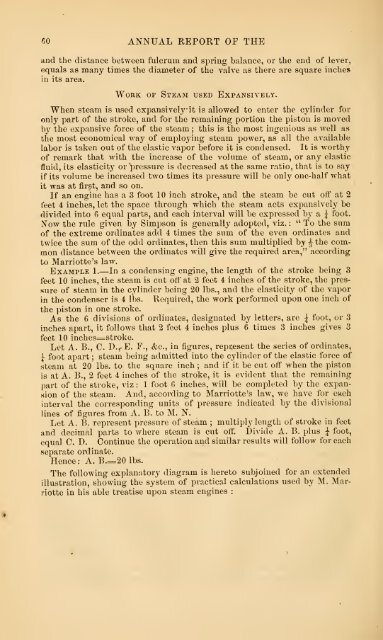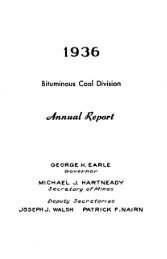1873 - Old Forge Coal Mines
1873 - Old Forge Coal Mines
1873 - Old Forge Coal Mines
Create successful ePaper yourself
Turn your PDF publications into a flip-book with our unique Google optimized e-Paper software.
60 ANNUAL REPORT OF THE<br />
and the distance between fulcrum and spring balance, or the end of lever,<br />
equals as many times the diameter of the valve as there are square inches<br />
in its area.<br />
Work of<br />
Steam used Expansively.<br />
When steam is used expansively it is allowed to<br />
enter the cylinder for<br />
only part of the stroke, and for the remaining portion the piston is moved<br />
by the expansive force of the steam ; this is the most ingenious as well as<br />
the most economical way of employing steam power, as all the available<br />
labor is taken out of the elastic vapor before it is condensed. It is worthy<br />
of remark that with the increase of the volume of steam, or any elastic<br />
fluid, its elasticity or "pressure is decreased at the same ratio, that is to say<br />
if its volume be increased two times its pressure will be only one-half what<br />
it was at first, and so on.<br />
If an engine has a 3 foot 10 inch stroke, and the steam be cut off at 2<br />
feet 4 inches, let the space through which the steam acts expansively be<br />
divided into 6 equal parts, and each interval will be expressed by a \ foot.<br />
Now the rule given by Simpson is generally adopted, viz. :<br />
" To the sum<br />
of the extreme ordinates add 4 times the sum of the even ordinates and<br />
twice the sum of the odd ordinates, then this sum multiplied by ^ the common<br />
distance between the ordinates will give the required area," according<br />
to Marriotte's law.<br />
Example 1.—In a condensing engine, the length of the stroke being 3<br />
feet 10 inches, the steam is cut off at 2 feet 4 inches of the stroke, the pressure<br />
of steam in the cylinder being 20 lbs., and the elasticity of the vapor<br />
in the condenser is 4 lbs. Required, the work performed upon one inch of<br />
the piston in one stroke.<br />
As the 6 divisions of ordinates, designated by letters, are \ foot, or 3<br />
inches apart, it follows that 2 feet 4 inches plus 6 times 3 inches gives 3<br />
feet 10 inches=stroke.<br />
Let A. B., C. D.,. E. F., &c, in figures, represent the series of ordinates,<br />
\ foot apart ; steam being admitted into the cylinder of the elastic force of<br />
steam at 20 lbs. to the square inch ; and if it be cut off when the piston<br />
is at A. B., 2 feet 4 inches of the stroke, it is evident that the remaining<br />
part of the stroke, viz : 1 foot 6 inches, will be completed by the expansion<br />
of the steam. And, according to Marriotte's law, we have for each<br />
interval the corresponding units of pressure indicated by the divisional<br />
lines of figures from A. B. to M. N.<br />
Let A. B. represent pressure of steam ;<br />
multiply length of stroke in feet<br />
and decimal parts to where steam is cut off. Divide A. B. plus £ foot,<br />
equal C. D. Continue the operation and similar results will follow for each<br />
separate ordinate.<br />
Hence : A. B.=:20 lbs.<br />
The following explanatory diagram is hereto subjoined for an extended<br />
illustration, showing the system of practical calculations used by M. Marriotte<br />
in his able treatise upon steam engines :




![1945 Anthracite Annual Report Districts 19 - 25 [Adobe pdf - 9148Kb]](https://img.yumpu.com/50308099/1/190x119/1945-anthracite-annual-report-districts-19-25-adobe-pdf-9148kb.jpg?quality=85)


![1937 Anthracite Annual Report Districts 1 - 11 [Adobe pdf - 9394Kb]](https://img.yumpu.com/43539962/1/190x119/1937-anthracite-annual-report-districts-1-11-adobe-pdf-9394kb.jpg?quality=85)






![1931 Anthracite Annual Report Districts 1 - 11 [Adobe pdf - 8007Kb]](https://img.yumpu.com/39427789/1/190x119/1931-anthracite-annual-report-districts-1-11-adobe-pdf-8007kb.jpg?quality=85)

